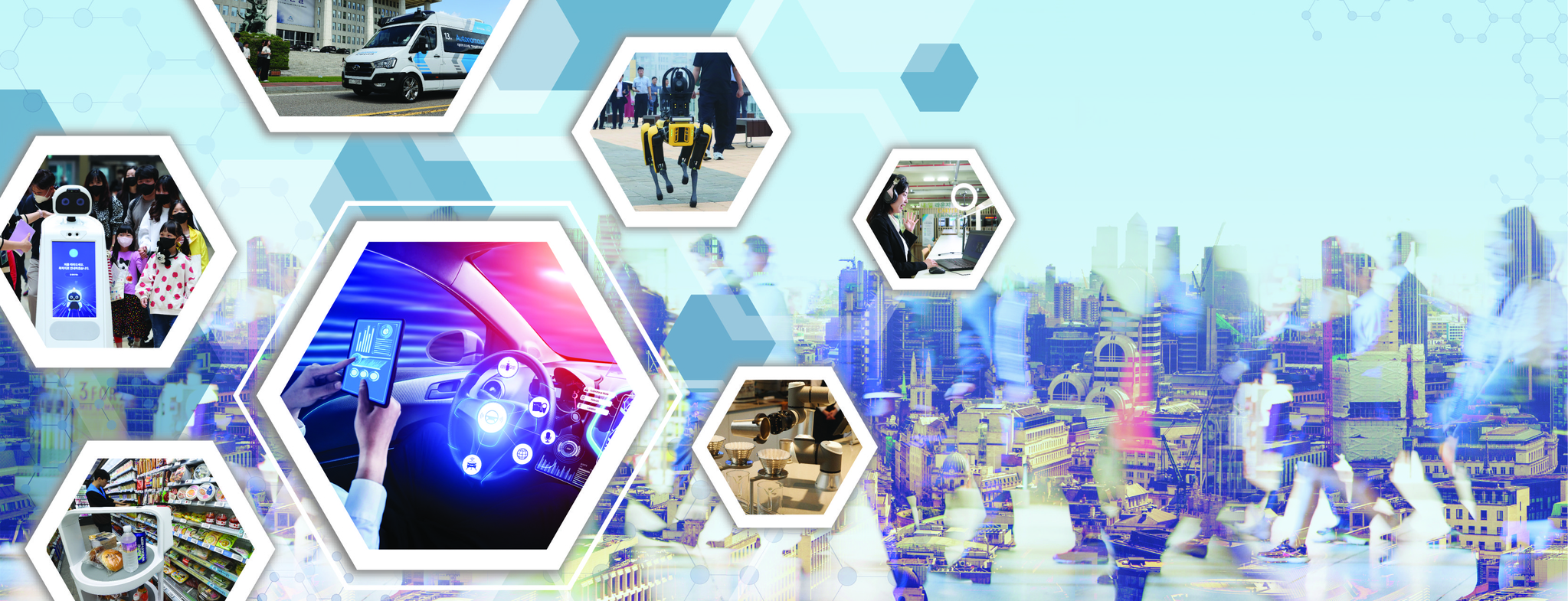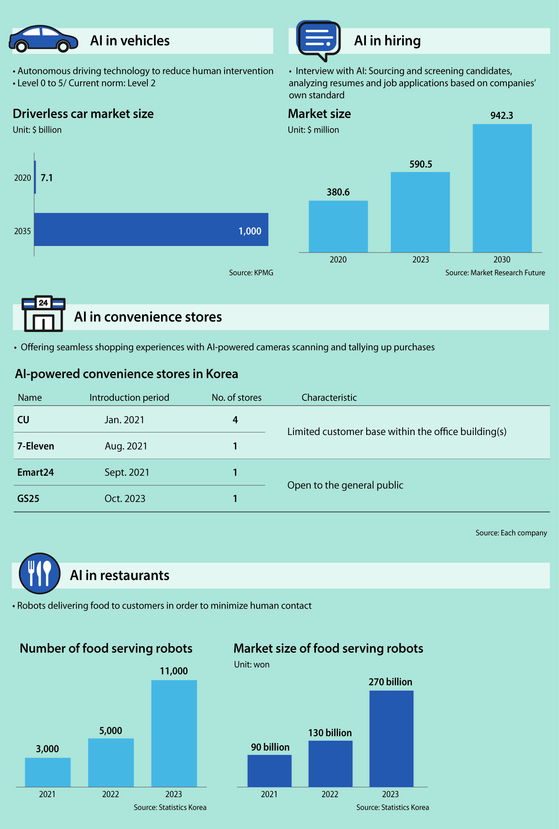[AI IN ACTION] Automated job interviews and self-driving cars: Inside Korea’s everyday AI
-

- SARAH CHEA
- chea.sarah@joongang.co.kr
-

- PARK EUN-JEE
- park.eunjee@joongang.co.kr

From cars to restaurants and even hiring processes, AI has already seeped into people's everyday life.
The daily routine of Kim Min-seok, a 33-year-old man living in Seoul, is closely interwoven with AI from the start of the day to the end.
Getting into his Tesla for a two-hour daily commute to Suwon, Gyeonggi, he occasionally takes his hands off the steering wheel for a while thanks to the car's Autopilot system. Then, he takes out his smartphone and searches for a nearby subway store. He tells his navigation to find the route to get there and make sure the store has a kiosk to avoid long queues. After grabbing a sandwich, Kim also stops by his favorite café where a robotic arm makes an iced Americano for him, a chain of tasks made available by multiple AI algorithms and other related technologies.
Only five years ago, the life of Kim could be replicated by a small force of affluent technology enthusiasts, but it is now more common, especially among young generations in Korea.
The arrival of ChatGPT has taken AI integration to the next level as Kim became more dependent on the system to not only acquire information but also summarize and grasp the complex issues for his research project.
"I sometimes use ChatGPT when I have to do research on a relatively complicated topic and ask it to tell me all it knows about that subject," added Kim, who works as an engineer. "ChatGPT is not entirely perfect or accurate, but it is still smart enough when outlining my work by myself."
Though the AI found in daily life is less complicated, which the industry calls a weak AI, or narrow AI, it has slowly been expanding its scope and has now seeped deep into people's daily lives.
"With the development of machine learning and pattern recognition, AI started to apply in everyday life in 2000s," said Kim Yoon-chung, a researcher at the Korea Institute of Science and Technology Evolution and Planning (KISTEP).
"AI technologies have been emerging as a key industry that values human convenience and safety," Kim added.
![RoboShuttle, a self-driving bus developed by Hyundai Motor, operates at the National Assembly in Yeouido, western Seoul, on July 5. [YONHAP]](https://koreajoongangdaily.joins.com/data/photo/2023/10/24/6e18045c-43be-4c6e-9d1a-1af3a7290bb7.jpg)
RoboShuttle, a self-driving bus developed by Hyundai Motor, operates at the National Assembly in Yeouido, western Seoul, on July 5. [YONHAP]
Autonomous driving going mainstream
With AI being applied in diverse scenarios, vehicles are one of the big scopes where AI can extend its ability to reduce fatal accidents and even make their time more pleasant.
Wandering around the Cheonggyecheon area in central Seoul, people could easily find autonomous-driving buses made by 42dot that come with Level 4 technology.
Though a driver is present in the driver seat, the bus theoretically runs on its own except in some cases such as in children's protection zones. Cars with Level 4 autonomous technology can operate on their own but may need human intervention.
A Level 5 vehicle can manage all scenarios on its own, which is not technologically possible yet, according to the U.S. Society of Automotive Engineers.
Cars have Level 2 as a current norm, Korea aims to commercialize them by the end of 2027. 42dot has been testing three self-driving buses near the Cheonggyecheon area and another three self-driving buses in Sangam-dong of the Mapo District, western Seoul.

Tesla's Autopilot still applies Level 2, which is generally called an advanced driving assistance system that takes control over steering, braking and acceleration in very specific situations, including low-traffic environments like highways.
Around 33 percent of new cars sold in the United States, Europe, Japan and China have at least some level of automation as of 2021, with almost all modern cars coming with Level 2 autonomous technology.
The number is estimated to surpass 50 percent before 2030, according to data from Statistics Korea.
Honda and Mercedes-Benz introduced cars with partial Level 3 at limited distances.
Kia will roll out EV9 GT which can run on highways with Level 3 technology.
"It may take decades to develop a completely automatic car, but if developments proceed over time, it can successfully increase the safety and convenience of drivers and passengers," said Huh Kun-soo, an automotive engineering professor at Hanyang University.
The increased role of AI has clear outcomes that will radically change the ways people interact with technology. The world is pushing hard to develop weak AI, a type that focuses on performing a specific task such as answering questions, to even the next level, strong AI, where the machine would require an intelligence equal to humans and have a self-aware consciousness that has the ability to solve problems, learn and plan for the future.
Its main goal is to reach a Super AI that is capable of surpassing human intelligence in all areas.
Korea Institute of Science and Technology Information predicts cars with Level 3 or higher technology will make up 54 percent of all self-driving cars on the roads by 2030.
The market size will grow from $150 billion in 2025 to $1.1 trillion in 2035.
![A job applicant gets a job interview with AI at Ewha Womans University in western Seoul. [WOO SANG-JO]](https://koreajoongangdaily.joins.com/data/photo/2023/10/24/49c7a41e-bd67-4b46-b357-16c013a18e8f.jpg)
A job applicant gets a job interview with AI at Ewha Womans University in western Seoul. [WOO SANG-JO]
Your next interviewer: AI
AI is taking over the seat of job interviewer, with major Korean companies including the four big — Samsung, Hyundai, SK, and LG — all having it as one of their steps before selecting successful candidates.
A 26-year-old Yoo, a job-seeker living in Seoul, recently failed to get a job, which was her fifth failure in the year.
"I applied for five companies and three of the failures were made after an interview with the AI," Yoo said. "I believe companies all have their own standard but the fact that I was eliminated by an AI is still unpleasant."
In an AI-assisted interview, a job candidate is presented with questions on screen in text form that they answer and submit via either text or video. A recruiter or other company staffer involved in hiring then evaluates the submission to assess if the applicant is a good fit.
Nearly 16 percent of 252 firms of Korea's 500 largest companies in terms of sales use AI in their process of interviewing candidates, according to the Ministry of Employment and Labor. Of them, 94.2 percent said they are willing to use it next year as well.
The use of AI is more evident overseas, with a recent survey finding that at least 99 percent of all Fortune 500 companies are now using AI tools in their hiring process.
Goldman Sachs, the world's second-largest investment bank, hired 3,700 interns out of 236,000 applicants using AI technology last year.
"The company can save time and cost, which is the biggest reason why companies now prefer AI interviews," said a 31-year-old Lee, who works at a Human Resource team at one of Korea's biggest insurance companies.
"It also improves the transparency as it reduces the risks of judges using their own perception when examining applicants."
![A shopper picks up items and walks out without paying at the checkout at Emart24 Smart Coex branch in southern Seoul, which is an AI-vision-based checkout-free store. [SEO JI-EUN]](https://koreajoongangdaily.joins.com/data/photo/2023/10/24/dee979bd-f1d2-4557-8af1-4e7167ea6e08.gif)
A shopper picks up items and walks out without paying at the checkout at Emart24 Smart Coex branch in southern Seoul, which is an AI-vision-based checkout-free store. [SEO JI-EUN]
'Grab-and-go' shopping
The introduction of AI-powered retail technology gave birth to different shops that adopted a grab-and-go payment system without checkout.
As you step inside an Emart24 branch located in COEX, southern Seoul, you won't be greeted by the friendly human staff, but by a quiet, automated atmosphere.
The entry process itself is a unique experience — you must authenticate your credit or debit card at a kiosk, and input the number of people entering, and only then are you granted access.
The biggest feature of the store, which is often referred to as the Korean version of Amazon Go, is the absence of a traditional checkout counter. Instead, as you grab your items and exit, after a few seconds, your mobile phone displays the purchased products and the total amount, with an automatic payment made through the authenticated card.
The process of automatic payment relies on a network of more than 30 AI-equipped cameras installed on the ceiling as well as weight detection sensors, which track customer and product movements while also discerning changes in weight. The system not only recognizes standard purchase behaviors but also unusual situations, such as a customer collapsing or requiring assistance.
![Emart24's AI chatbot, Smartrie, responds to a customer's query by locating Oreos in the store. [SEO JI-EUN]](https://koreajoongangdaily.joins.com/data/photo/2023/10/24/9346a40d-4fa3-4ce8-b3f5-02e9ab82df28.gif)
Emart24's AI chatbot, Smartrie, responds to a customer's query by locating Oreos in the store. [SEO JI-EUN]
The AI chatbot transforms spoken words into written text and then interprets the text to provide users with the requested information. It can also provide information about special offers like buy one, get one free items.
Utilizing AI for big data collection is also a feature of the smart convenience stores that operate behind the scenes. It enables the segmentation of customer purchases based on various factors like product selection, time, weather and seasons. AI then analyzes this data to assist in store management, providing recommendations for product displays and quantities, essentially stepping into the role of a store manager.
![At GS25 DX Lab in Gangnam District, southern Seoul, customers have the option to order beer from GS25's unmanned alcohol vending machine. The system allows customers to verify their age through a mobile application, eliminating the need for human staff to confirm their age. [SEO JI-EUN]](https://koreajoongangdaily.joins.com/data/photo/2023/10/24/21bea5ef-4706-42aa-bc14-8d11d1de2682.gif)
At GS25 DX Lab in Gangnam District, southern Seoul, customers have the option to order beer from GS25's unmanned alcohol vending machine. The system allows customers to verify their age through a mobile application, eliminating the need for human staff to confirm their age. [SEO JI-EUN]
Nonetheless, stores like Emart24 Smart Coex branch and GS25 DX Lab have adopted automated vending machines for cigarettes and alcohol. Customers can purchase these items by verifying their age using the PASS mobile application.
The move toward unmanned stores is influenced by various factors, including rising labor costs and the need to expand late-night sales, as well as customers who prefer to shop quietly.
"I don't like interacting with staff and having them follow me around explaining products at manned stores," said 27-year-old Park Jin-ah living in Seoul, who frequently visits unmanned ice cream shops. "When I need something nearby, I deliberately choose unmanned ice cream stores over convenience stores."
The shift toward unmanned operations is most notable within convenience stores, echoing the model of Amazon Go. The number of unmanned stores operated by the four major convenience store chains — CU, GS25, 7-Eleven, Emart24 — grew by nearly 16-fold more than the past four years, totaling 3,310 stores as of last year.
![A serving robot at Ramos Burger in Chuncheon, Gangwon, delivers plates of hamburgers to a specific table. There is an increasing prevalence of such food-serving robots in Korean restaurants. [SEO JI-EUN]](https://koreajoongangdaily.joins.com/data/photo/2023/10/24/542edf60-60fa-4fda-98d9-98289aa7ee74.gif)
A serving robot at Ramos Burger in Chuncheon, Gangwon, delivers plates of hamburgers to a specific table. There is an increasing prevalence of such food-serving robots in Korean restaurants. [SEO JI-EUN]
Self-wheeling food servers
A bustling hamburger joint in the heart of Chuncheon, Gangwon, accommodating around 60 patrons being served by a single robotic server along with three waitstaff.
While the need for human staff is evident, the scarcity of available employees in this remote locale prompted a novel solution.
The answer came in the form of a serving robot, introduced in 2021, capable of transporting meals for up to six people on three shelves. Alongside this innovation, the installation of a kiosk ordering system at the restaurant's entrance alleviated the growing workforce shortage.
"With robots handling routine tasks, our operation has not only become more efficient but also significantly more convenient for our human staff," said Ramos Koo, a 40-year-old owner of Ramos Burger.
The transition has not only lightened the burden of labor but has also garnered a positive response from customers.
"Some customers, especially kids, prefer robots more than traditional human service," Koo shared. "During peak hours, they have, at times, expressed disappointment when their orders were delivered by human waitstaff."
Serving robots come at a monthly rental cost of 300,000 won ($222), offering an economically viable alternative to the expenses associated with human employees, including salaries, allowances and insurance. Though their current capabilities are limited to serving, the rising challenges of workforce recruitment have fueled the demand for serving robots in the food service industry.
While the introduction of serving robots is not without its concerns, such as potential malfunctions and customer reservations, their adoption has gained momentum due to the growing shortage of available labor and the increasingly challenging business environment.
![AI serving robots are getting ready to deliver food at a restaurant in Wanju District, North Jeolla. [YONHAP]](https://koreajoongangdaily.joins.com/data/photo/2023/10/24/32cb5d47-6988-4fc0-8439-84602b082d5a.jpg)
AI serving robots are getting ready to deliver food at a restaurant in Wanju District, North Jeolla. [YONHAP]
"Due to the rapidly declining population, Korea has seen a reduction in young individuals willing to engage in simple service roles that typically offer monthly wages of 1.5 to 2 million won," said Suh Yong-gu, a business administration professor at Sookmyung Women's University.
"The country's exceptionally low illiteracy rate, coupled with a high level of technological acceptance, has made kiosk usage widespread. Additionally, the preferences of younger generations for work-life balance have led to conflicts and tensions between employers and part-time employees."
BY SARAH CHEA, SEO JI-EUN [chea.sarah@joongang.co.kr]










with the Korea JoongAng Daily
To write comments, please log in to one of the accounts.
Standards Board Policy (0/250자)